There’s been a ton of negativity around Google Ads Express (formerly AdWords Express) and how smart/speedy they really are. One main gripe is that these automated ads turn up in non-relevant places, meaning wasted clicks - and wasted ad budget.
However, as with everything ‘Google’, the times they are a’ changin.
“Google Ads Express are now known as ‘Smart Campaigns’ and they come with some new and improved features. Given their recent makeover is it time to take a fresh look at these automated ads? Are they a valuable tool and if so, for whom?”
What are the upsides and downsides of using Express Ads in comparison to Google Ads - and how do you wring the most value out of them?
- Quick recap:
- Smart Campaigns – “same same, but different”
- So what’s the deal with Google Ads Express?
- Getting started with Google Express Ads
- The debate between classic Google Ads Vs Google Ads Express
- Why you might prefer Google Ads
- Tips for optimizing Google Ads Express
- Be on alert for ad suggestions
- Final takeaways
Get brand new Google ad strategies straight to your inbox every week. 23,739 people already are!
Google Ads identity crisis: am I an Express Ad, a smart campaign, or what?
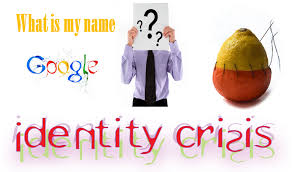
There may be some latent confusion over what exactly Google Express Ads means.
Try not to get too existential on me just yet - image source
Is it the same as AdWords Express? What about these new Smart Campaigns on the Google Marketing Platform? Seems like there’s some questions we need to clear up before we get started.
So, let’s regroup and have a little refresher course, shall we?
Quick recap:
Google AdWords is now so much more than words – we’re talking pictures, videos, product advertising (shopping) etc.,etc.,
So much so that Google has rebranded ‘Words’ as ‘Ads.’ Google Ads is now the umbrella that covers most Google Advertising channels.

Here’s the first big change we need to remember - image source
Google AdWords Express = Google Ads made simple
Google AdWords Express was introduced back in 2011 to help small business owners take their first steps into the world of online advertising.
The idea was that anyone could set up an effective AdWords campaign in minutes with no PPC knowledge required.
“Set up your online ad in 15 minutes and let Google do the rest.”
Google AdWords Express provided a way to get started with PPC advertising on a lowish budget without having to do hours of keyword research, craft ad copy - or understand the ins and outs of bidding strategy.
Despite all the negativity around AdWords Express (and while Google never released specific figures around their adoption), take-up was likely significant.
A 2017 report by LSAInsider suggested that around 57% of SMB marketing providers were using Google Adwords Express to manage SMBs paid search campaigns.
“Here at KlientBoost alone, 25% of the lower level leads that we audit are using or were using Google Ads Express – which just goes to show how much small businesses have invested in easy PPC setup.”
What solidifies the statistic even more is that we only see these Smart Campaigns on our low budget, low level leads.
Once we start dealing with budgets in the $5-10K monthly spend range, the percentage of Smart Campaign we see drops below 5% as we see brands investing in full fledged SEM.
In 2018 AdWords Express became Google Ads Express
Under the new Google Ads interface Google AdWords Express became known as Google Ads Express. With the new rebranding of Google Ads and the Google Marketing Platform came something else: Smart Campaigns.
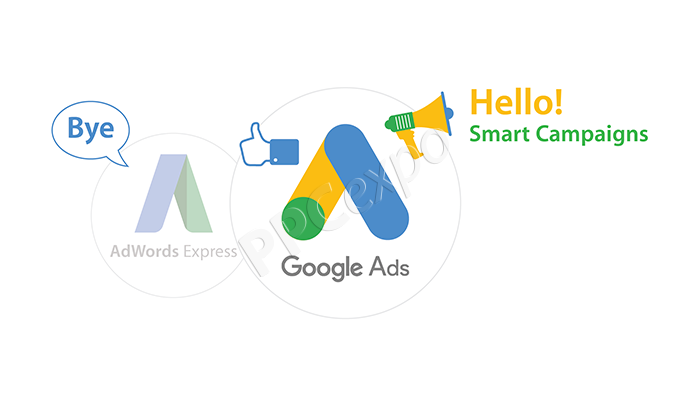
Here’s the next big difference - image source
Smart Campaigns – “same same, but different”
Smart Campaigns are based around the previous automated Google Ads Express platform but they’ve been bolstered up with new algorithms and reporting features.
According to Kim Spalding, Google’s Product Management Director:
"We built Smart Campaigns by tailoring the innovation and advertising technology available with Google Ads for small business owners. You can now create ads in minutes and drive real results - like making your phone ring, sending leads to your website, or bringing customers to your store.”
However, this doesn't make Smart Campaigns the same as the original Google Ads Express. While Google Ads Express will help expedite your setup and the launching of your PPC campaigns, it still requires you to manually manage certain aspects.
Smart Campaigns, on the other hand, take the reigns nearly entirely out of your hands by automating bids, placements, audiences, copy and creative combinations, and even testing.
Google Ads Express is meant to help you get started quickly and is meant to manage small level campaigns for entry level advertisers.
But Smart Campaigns are often used in well established campaigns to help automate optimization and scale campaigns. So, we'll save them for another post.
So what’s the deal with Google Ads Express?
Now, Google Ads Express allows you to create PPC ads that show up in Search, on Google Maps, and on Display. All based on minimal effort from you.
Google’s smart new technology takes the helm and helps you create ads in minutes.
In just a few minutes your Google Ad could look like this:

Courtesy of Google Support - image source
What features does Google Ads Express offer?
According to Google, The Expression version of their ad platform still has quite the comprehensive set of features.
You can check out what each of these available features does (more or less) in the screenshot below.
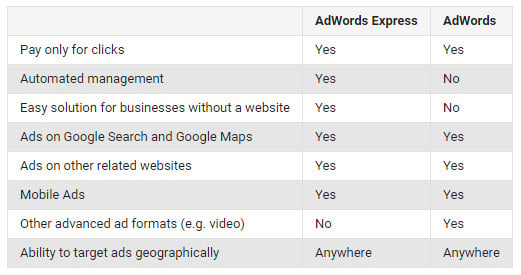
The “About Google Ads Express” page is a good place to start - image source
Getting started with Google Express Ads
It’s super-simple to get up and running – let's run through the steps.
Step 1:
If you go in via the old interface you’ll see this:
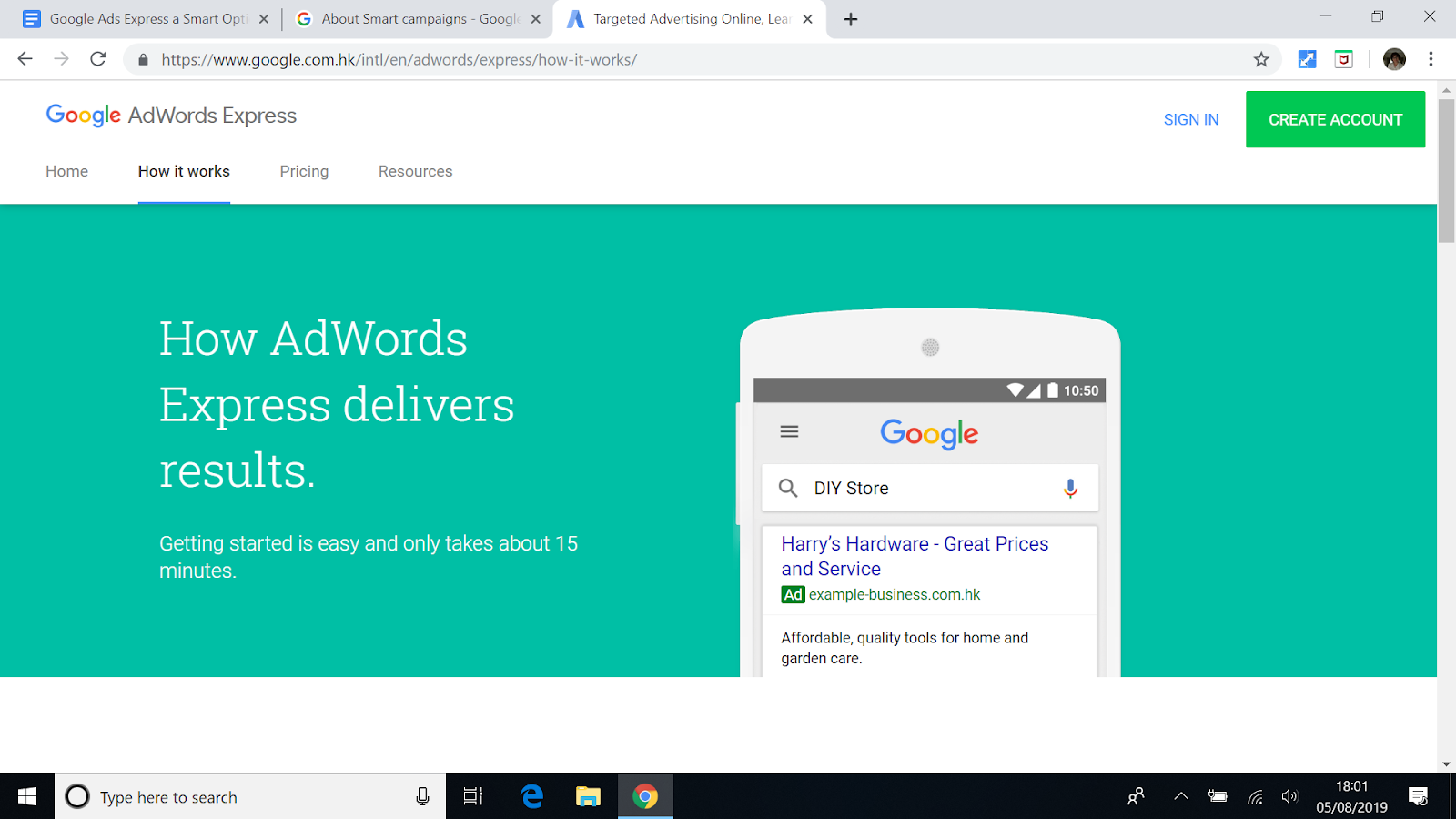
You can consider this the homepage for Express campaigns.
Click on ‘create account’ (top left) and you’ll be redirected to the page below.

This helps Google determine bid types and strategy for you.
At the bottom you’ll see a link to ‘Experienced with Google Ads?’
If you click this you’ll be taken to the Google Ads setup. If you decide to take this option this guide will help get you started.
But since we’re creating an Express Ad we’ll go ahead and choose one of the proposed advertising goals instead. For example, if your aim is to get more customers to visit your brick & mortar store click down to the second option. At the next screen confirm this as your goal.
Step 2:
The next step is to input your business name and website (if you have one). If you don’t have a website you’re given the option to create a ‘Google my Business listing’ on maps option.
You can’t create an ad without at least doing this.
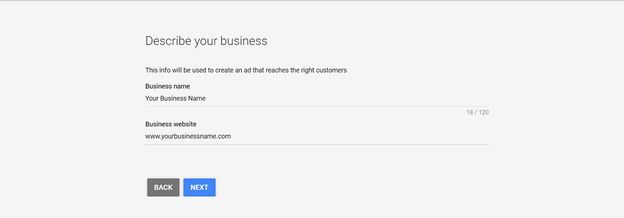
You do need somewhere to send your traffic/calls, after all…
Step 3:
Next you’ll be asked to specify a location for where you’d like the ads to run. You have the option to set up a radius around your business, or cite a specific area.
On the right side of the page Google tells you how many people you can reach in your chosen location (a bigger audience size doesn’t mean a bigger cost).
Here’s what Google says about selecting a location:
“You’ll want your ads to appear in the places that your business serves – for example, if you want to reach customers that are 30 miles from your business, make sure that you target your ads accordingly. This also keeps your ads from appearing in areas that your business doesn’t serve.”
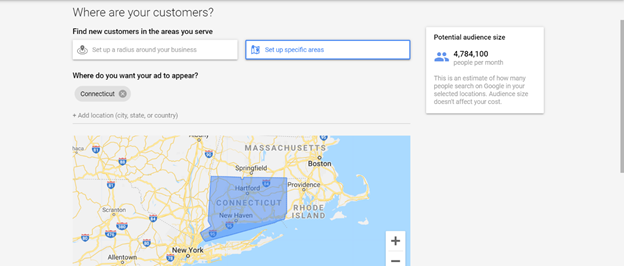
This can really help SMBs with local advertising strategies in mind...
Step 4:
Specify your language and business category – what best describes what you do?

This goes without saying, but you should know this answer well.
Step 5:
You’ll then be prompted to tell Google which products or services you provide. They’ll provide you with suggested products and service phrases based on your business info and website – plus, you can choose to add your own. You can view the potential audience size on the right.
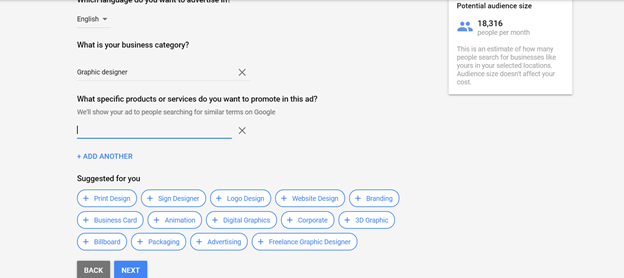
Now we’re approaching the fun part. Excited yet?
Step 6:
Onto the ‘Let’s write your ad’ page where you can get creative (sort of...remember, with Smart Campaigns Google is doing most of the lifting).
Google has already come up with some ideas to get you started along with a possible layout. Don’t simply opt for Google’s suggestion though - it’s highly recommended you customize your ad.
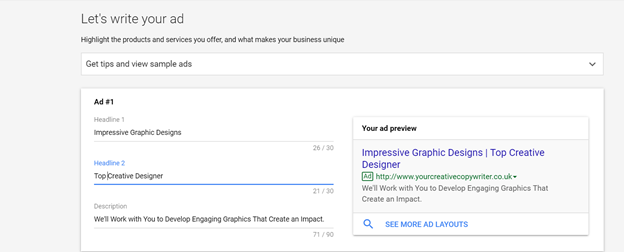
Don’t just be a sheep, be your own shepherd too!
To at least cover your bases you need to write two headlines along with a description for your ad. You can view some tips for optimizing your ad copy by reading this article.
You can also checkout the breakdown below of a Smart Ad with the max number of characters per field (plus where each section links to):
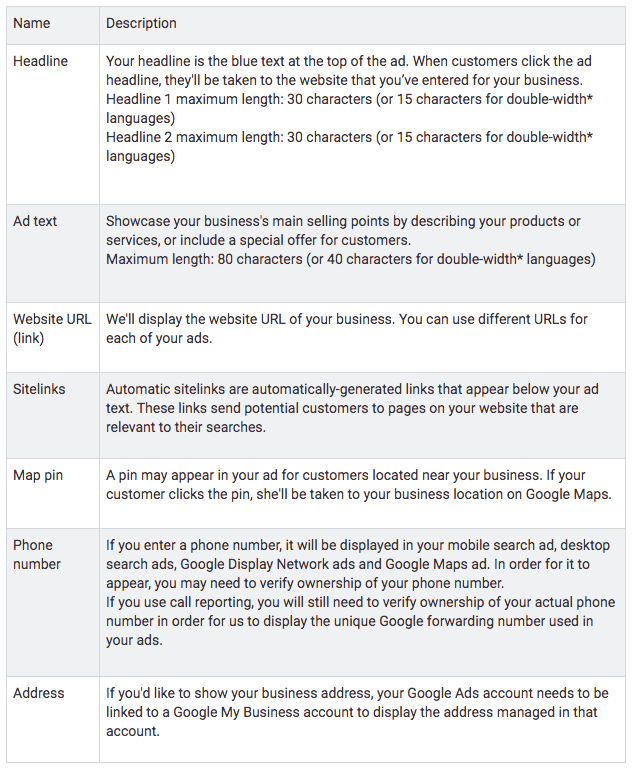
A nice, savable little template for your Express setup.
You can also view more potential ad layouts if you click under ‘Your ad Preview.’
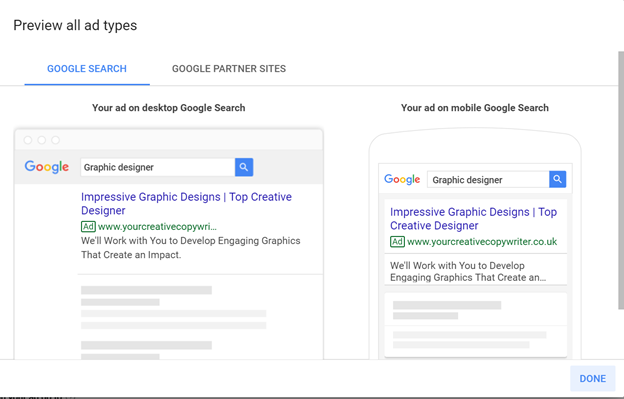
This gives you both the desktop and mobile view (great for local campaigns).
Then you have the option to write another Ad – which we’d highly suggest.

We are fans of customization here at KB, though...
Step 7:
Here you’ll be given the option to add your telephone number.

Again, it’s pretty straight forward.
Step 8:
Then, if you want to bolster up your campaign arsenal just a tad, you can add an image i.e. create a ‘display’ ad.
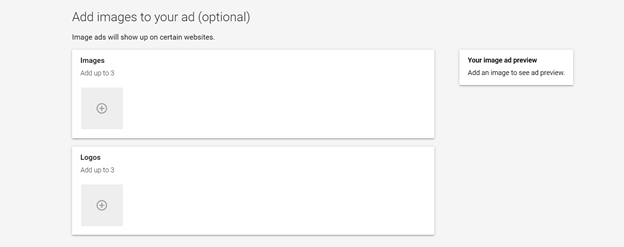
It’s a little difference that really does open up Google’s advertising reach.
Step 9:
Next you need to set your budget. Google will recommend a budget based on the average number of clicks for your business category and location. Select a budget you’re happy with, as in one that allows you to show your ads as often as you’d prefer.
You can change your average or monthly budget at any time and whenever you like.
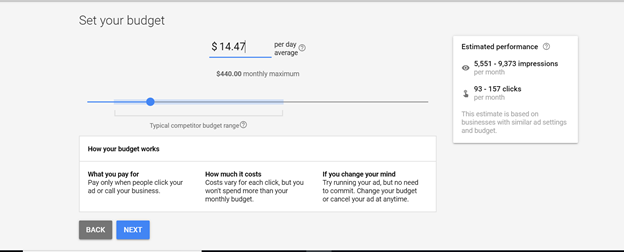
The “Typical competitor budget range” is helpful bar to help you understand your relative position as well.
Step 10:
Now you finally get to move on to ‘Review your ad settings’. Here you can see your estimated performance in terms of impressions and clicks per month.
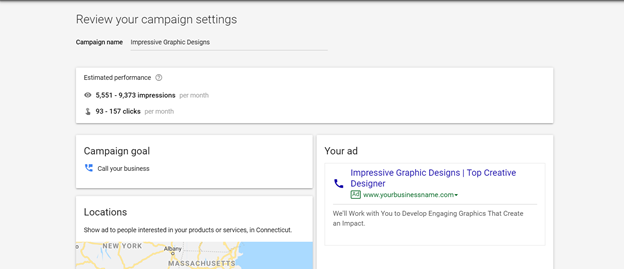
Don’t ever sleep on the importance of double checking ad settings.
Your Ad Settings matter. Simple as that.
“Even if you’re running automated campaigns, taking the time to double check your ad settings is always worthwhile if you’re avoiding wasteful budget burn and saving yourself time/money by taking five seconds to fix small but costly manual errors.”
And with the release of Google Ads Settings and ad personalization, your ad settings matter even more now. So don’t sleep on double checking this screen.
Now, this screen can do more than just double check your settings. Here you can also edit images, business category, and budget.
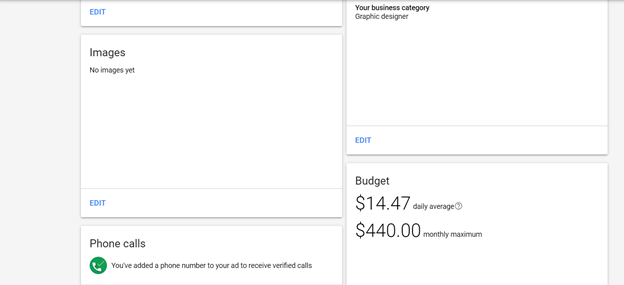
It’s a nice overview of most of the things you’ll want to be tracking.
You can see and edit your ads, pause campaigns, or even schedule when your ad will run.
This hub tracks nearly everything within your Express campaigns' performance. So you can manage your search phrases here and even view your Google Analytics account if you have it connected.
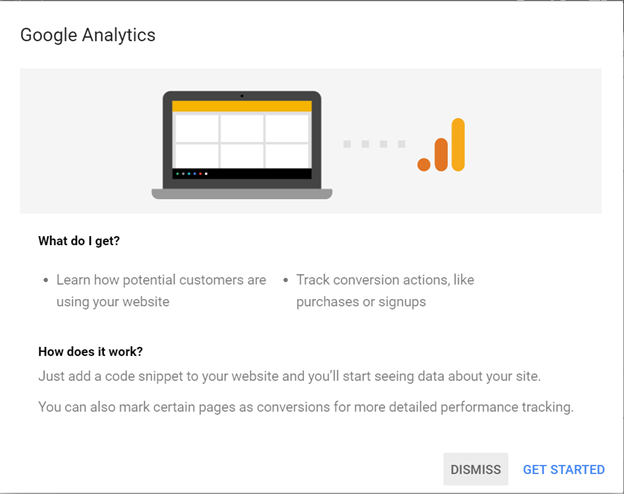
Or, if you don’t, you can find out how to set up an account and connect it s you can better track and optimize your ads.
For more information about using Google Analytics setups, click here.
Once you’ve reviewed your ad (and have entered your payment details) your ad will be live. Now you can just sit back, relax, and – wait. Hold up.
The debate between classic Google Ads Vs Google Ads Express
For the sake of all readers, we should take the time to mention that taking the short cut with Google Ads Express might not be for everyone.
As referenced before, the larger the monthly budget gets, the less likely those managers tend to be in terms of using Google Ads Express.
It's also important to re-emphasize that Smart Campaigns aren't for you if you're looking to maintain any manual control over your campaigns.
However, regardless of Smart Campaigns, if you're considering leaning on Google Ads Express versus fully investing into Google Ads, there are definitely pros to both. So let’s take a look at Google Ads Express first.
The short case for Google Ads Express
Here’s a list of the pros for using Google Ads Express, as opposed to classic Google search ads campaigns.
- Ease of Use: Google Ads Express can be up and running in minutes. Simply follow the simple steps we just outlined (make sure you’ve entered your payment details) and job done
- You don’t need a website to get started - you can create a Business Maps Listing instead
- You don’t have to worry about targeting. Google will target your ads to the categories you specify
- Automation: no need for manual keyword analysis - Google automatically places your ad to be seen in related categories
- You can target customers on desktop, mobile and tablet
- You can schedule when your ad should run. (If you’re goal is to get more calls, schedule your ads for when you’re around to receive them - otherwise you’re wasting clicks.)
- It’s cost-effective - you only pay for clicks
- You get a local search boost. A Google Maps Listing encourages people to drop by your store if they are in your area
- You now have better insights into how your ads are performing using the dashboard and Google Analytics
- Google tests ads via Alternate Text Ads: Google automatically runs alternate text ads based on the info you provide about your business and website content. Both the original and new ads will be run to create and test which are working best. Those that are performing better will run more often
- Smart Campaigns can run on both the Google Search Network and the Google Display Network. On the Search Network you can reach people as they actively search for specific goods or services
- The Display Network lets you grab someone’s attention earlier in the sales cycle. Your ads can be seen even before someone starts searching for something specific
Why you might prefer Google Ads
And here’s a list of the pros for using the classic Google Ads platform instead of letting Google take the reigns with Google Ads Express and smart campaigns.
- Google Ads Express can’t match Google Ads in terms of precision, efficiency or optimization
- With Google Ads you can narrow down to specific individual goals - e.g. increase leads, conversions or brand awareness (you can only set wide goals)
- Google Ads also allow you to advertise on a wider range of Google properties than Google Ads Express e.g apps and YouTube, and you - rather than Google - decide where they’re shown
- With Google Ads you have better targeting options - and the ability to target by location even down to Zip Code. This means you can bid higher for locations that are working for you. You can also exclude locations.
- Google Ads Express use ‘broad match’ so your ads can show up on misspelled searches, synonyms and related searches. If you sell ‘ladies hats,’ for example, your ads could show up for ‘ladies scarves’ or another less-than-relevant term. So while ‘broad match’ gives Google the option to increase the reach of your ads, it may be driving unqualified traffic your way. Reach doesn’t necessarily equal engagement or conversion.
- Google Ads let you include negative keywords to exclude searches that aren’t relevant to your business. Specifically if you're using Smart Campaigns, you can't manage what you can exclude/not because Google is automatically handling your bid optimizations and keyword targeting.
- Because Google likes to make money for itself, it's not likely that it will exclude many audiences as it wants your ad to reach max visibility and clicks regardless of the quality of traffic is being generated for your business.
Now, it’s up to you which of these you choose to use. And, in the end, it’s going to be decided based on the specific goals of your actual advertising campaigns and the limitations of your own experience.
But we’ve come this far while maintaining focus on Google Ads Express. So, we might as well let you in on a few insider tips on how to optimize your Google Ads Express Campaigns.
However, we'll be waiting for you when you're ready to take it up a notch to the full blown Google Ads experience. ;)
Tips for optimizing Google Ads Express
You’ve made it this far into this beast of a post. So I hope you’re willing to go a little further if it means getting some insider tips on optimizing your Smart Campaigns. After all, there is no PPC without CRO to the true experts.
Take the time to write expert ad copy
Choose your words carefully. Consider what you want to highlight and create an ad that accurately reflects your business.
What makes your business unique? Speedy delivery? Competitive rates? Don’t be afraid to brag a little bit if it means distinguishing yourself from the crowd.
You also shouldn’t skip on any of these actionable tips:
- Include special deals and discounts
- Give a clear CTA, e.g. call today, make an appointment, etc., so customers know exactly what to do
- Include relevant search terms to show your ad is relevant and matches their actual search intent, not just the keyword
- Make sure grammar and spelling are spot on and use all lines of description fields. Don’t let sloppiness cost you leads.
Provide a strong website experience
I’ve said this in countless blog posts before and I’ll continue to say it until I’m out of a job I presume:
“In today’s post-digital world, having a clean and solid website isn’t something that impresses users. It’s a prerequisite. Everyone has a half-decent website these days. It’s up to you to distinguish yourself and your brand in the eyes of users who are constantly bombarded by digital media.”

Don’t have a panic attack yet, there are people who can help - image source
Make sure that once visitors get to your website, they find what they came for. Put yourself in your customers’ shoes and choose a landing page that gives them all the information you promised them in the ad.
If customers can’t find what they're looking for, they’re more likely to leave.
If you need to learn more about message match, user experience, and optimizing your landing pages you can check out some good reads here.
Consider running multiple campaigns
This makes sense if you want to promote different aspects of your business. For example, a hat shop might want to create a general “hats” ad, but create an additional ad for “wedding hats”.
If you have multiple campaigns, you can devote more budget to one campaign, or divide your budget evenly between campaigns.
Bear in mind that your overall budget for Smart campaigns is the combined budget for all of your ads e.g. if you have 3 campaigns for your business and set a daily budget of $20 for each ad, your total budget will be up to $60 per day.
Learn from strong campaign examples
To help give you a better picture of what Google will be building for you, here are some examples of ads from Betty’s Beach Bikes, a (fictional) local bicycle shop.
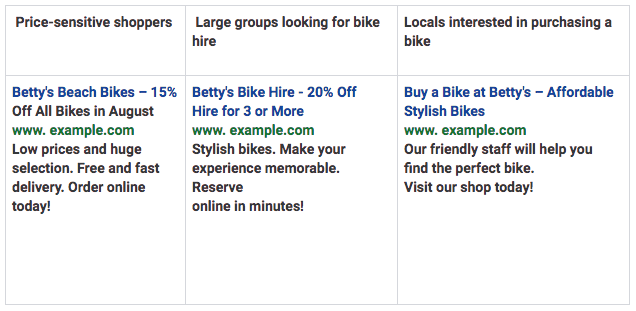
Betty offers various products and services, e.g. bike hire, bikes for sale, etc. so could benefit from writing different ads for each business category. They could look like this:
Written with a little help from our old friend Google - image source
More ads = more options to show the ideal message to each potential customer.
Google say ad groups that have three plus high-quality ads could get 5% to 15% more clicks or conversions – in contrast to ad groups featuring only one ad.
So, by setting up multiple campaigns and creating variations of your existing ads you’re also making the most of Google’s free ad copy optimization feature(and saving yourself precious time).
Be on alert for ad suggestions
Ad suggestions are variations of your existing text ads that may boost performance of your Smart campaigns.
To help improve performance, Google uses a combination of human review and machine learning to create high-quality ad suggestions.
Google optimizes ad copy based on relevant content from your account including from your existing ads, extensions and landing pages - as well as signals from keywords and targeting.
Ad suggestions will surface in your account dashboard as ‘Auto-Apply Suggestions’ for you to review, and you can choose to apply, edit, or dismiss them. If you ignore them these Ads will start serving after seven days.
Final takeaways
It takes time and dedication to understand the intricacies of Google Ads – from bidding strategies and demographics, to keywords and market competitiveness, the list grows longer every day. And time is something many small businesses don’t have in surplus.
Google Ads Express Smart Campaigns are easy to implement and could be a good starting point if you have limited employees or a low budget – or no prior knowledge of PPC.
If you want to start small and experiment with Google advertising (and get your ad in front of people who don’t know you) Google Ads Express could be for you.
Once you’ve found your feet, though, you may find this too limiting – and feel the need to branch out, moving onto the comprehensive Google Ads platform which gives you far more control.
For companies wanting to maximize ROI, Google Ads are probably a better choice. While the setup and management is more involved, simply taking a bit more time to understand Google Ads and PPC in general could be worth your while. There are plenty of guides out there to help you get to grips with Google Ads.
And if not, we’re always here to help.